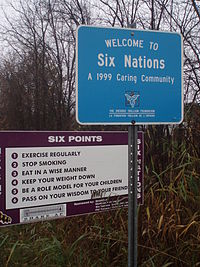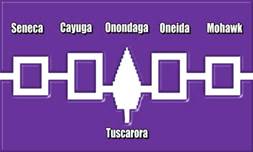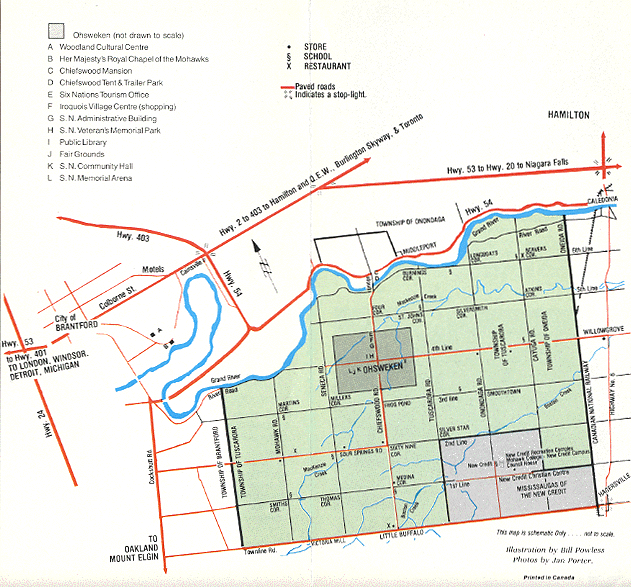Getting to know the Six Nation First Nation Community at Grand River Ontario
Getting to know the Six Nation First Nation Community at Grand River Ontario.
Link to the “Communities” Section





This community is not in NW Ontario. It is located on the Niagara Peninsula near Brantford Ontario. I developed this because a person we met came from this community and now lives in NW Ontario.
The Six Nations of the Grand River Territory is a league of nations comprised of the Onondaga, Cayuga, Seneca, Mohawk, Oneida, and Tuscarora. The Tuscarora who are originally from North Carolina joined the confederacy in 1722.
http://www.sixnationstourism.ca/index.php?id=our-history
Videos
Video of driving through town (18 min) 2014
https://www.youtube.com/watch?v=3LCkGzkcwH8
Bread and cheese celebration: Commemorating the relationship with the crown (2:30min)
https://www.youtube.com/watch?v=0CwaCsOqK3U
Six nation culture and heritage (2013 4 min)
https://www.youtube.com/watch?v=JEol8luLTM0
Six Nations of the Grand River
From Wikipedia, the free encyclopedia
Website www.sixnations.ca
Six Nations (or Six Nations of the Grand River) is the largest First Nations reserve in Canada with a total of 25,660 members. Some 12,271 are reported living on this reserve.[2] It is the only reserve in North America that has all six Iroquois nations living together.[citation needed] These nations are the Mohawk, Cayuga, Onondaga, Oneida, Seneca and Tuscarora. There are also some Delaware living in the territory.
The Six Nations reserve is bordered by the County of Brant, city of Brantford, ON, Norfolk County, Haldimand County, and has a subsection reservation, the New Credit Reserve located within it boundaries.The acreage at present covers some 46,000 acres (190 km2) near the city of Brantford, Ontario. This represents approximately 5% of the original 950,000 acres (3,800 km2) of land granted to the Six Nations by the 1784 Haldimand Treaty.
Link to Six Nations First Nation
About the Grand River Territory
The Grand River flows from its source south for approximately 300km through Grand Valley, Fergus, Elora, Waterloo, Kitchener, Brantford, Six Nations and Cayuga before emptying into the north shore of Lake Erie at Port Maitland. The Grand River is one of the cleanest in Ontario and achieved Canadian Heritage River status in 1994.
There are twelve Grand River Conservation Authority Parks along the river. Canoeing, kayaking, fishing, dinner cruises, and watching the wide variety of wildlife can be enjoyed throughout the year.
The Six Nations of the Grand River Territory is located in one of the last remaining Carolinian Forests in Ontario which are characterized primarily by a predominance of deciduous or broad-leaf trees. It is estimated that 90 per cent of Canada’s Carolinian forest has already been destroyed.
http://www.sixnationstourism.ca/index.php?id=our-history
The Histor of Six Nations of the Grand River
The Six Nations of the Grand River Territory is a league of nations comprised of the Onondaga, Cayuga, Seneca, Mohawk, Oneida, and Tuscarora. The Tuscarora who are originally from North Carolina joined the confederacy in 1722.
The traditional account of how the Iroquois Confederacy was formed began with “the Peacemaker” who brought teachings of the peace, power and righteousness which is known as “The Great Law of Peace”. “The Great Law of Peace” is the founding constitution of the Haudenosaunee Confederacy and is the underlying basis for our society. Fifty Chiefs, Clanmothers and Faithkeepers were appointed as the “Caretakers of the Law” each with their respective jobs and duties to follow. It is in this way that the “The Great Law of Peace” is perpetuated and remains intact and alive today.
The Chiefs pass their title down to their successors and are chosen by the Clanmothers who are the head of each Clan (family). The Clans include three each from the land, water and the sky – the Turtle, Eel, Beaver, Heron, Hawk, Snipe, Bear, Wolf and the Deer.
Haudenosaunee – “People of the Longhouse” are a matrilineal society, which means ones Clan and Nation are passed down to a child from his or her mother. People from the same Clan are not allowed to marry each other, as a Clan constitutes a familial relationship.
Six Nations Celebrities
There are many famous people who have come from the Six Nations of the Grand River. These notables include Jay Silverheels or better known as Tonto in the Lone Ranger, Academy nominated actor Graham Green – Dances with Wolves , Roberta Jamieson – Canada’s First Indigenous Female Lawyer and Ombudsman of Ontario, Santee Smith – trained with the National Ballet of Canada, Robbie Robertson – from the legendary rock group the Band, Stan Jonathan – played hockey for the NHL’s Boston Bruins, Gaylord Powless – one of Canada’s finest Lacrosse players, Tom Longboat – long distance Marathon runner, and Emily Pauline Johnson – renowned Mohawk Poetess.
Thomas Charles Longboat. July 4, 1886 – January 9, 1949
Early in his life, it became clear that Longboat had the ability to become a great runner. Longboat’s first important race took place in 1906 when he won the “Around the Bay Race,” an annual Marathon in Hamilton, Ontario. After taking his victory, it is said that Tom ran home after the race. When he won the 1907 Boston Marathon with a record time of two hours, twenty-five minute and four seconds, Tom Longboat became the world’s premiere marathon runner. By 1910 he was widely recognized as one of Canada’s leading athletes. In 1912, after turning professional, he set the record of one hour, eighteen minutes and ten seconds for fifteen miles-seven minutes faster than his old amateur record. During the first World War, Longboat served as a dispatch runner in France and raced professionally as often as possible. After the war, Longboat returned to Canada and settled in Toronto. He retired to the Six Nations Territory and died of pneumonia on January 9, 1949. Tom had become a legend in his own lifetime and so he shall remain. In 2010, the Ontario Legislature proclaimed every year on June 4th to be “Tom Longboat Day”.
- Pauline Johnson. March 10, 1861 – March 7, 1913
Tekahionwake or E. Pauline Johnson was the daughter of a Mohawk Chief, George Johnson, and his English born wife Emily S. Howells. Pauline was born on March 10, 1861 on Six Nations of the Grand River Territory. Pauline received little formal education, yet she had a natural aptitude for literature and began to write poetry at an early age.
At the turn of the century, Pauline Johnson was one of Canada’s most popular and successful entertainers and writers. At the age of 31 when society expected her to marry and begin a family, she began to tour the country instead. She gave popular recitals of her poetry, comedy routines, and plays from Halifax to Vancouver. She was also one of the few female writers at the time that could make an independent living from what she wrote and performed. Pauline Johnson was proud of her native heritage and wrote: “My aim, my joy, my pride is to sing the glories of my people.” Pauline Johnson died in Vancouver on March 7, 1913 and is one of the only people to be buried in the cities Stanley Park.
http://www.sixnationstourism.ca/index.php?id=our-history
History
Many of the Iroquois people allied with the British during the American Revolutionary War, particularly from the Mohawk, Cayuga, Onondaga and Seneca nations. Some warriors of the Oneida and Tuscarora also allied with them, as warfare was highly decentralized. These nations had longstanding trade relations with the British and hoped they might stop European-American encroachment on their territories. These allies were from the Six Nations of the Haudenosaunee or Iroquois Confederacy. After the colonists’ victory, the British government ceded all of its territory in the colonies, including that belonging to the Six Nations and without consulting them or making them party to treaty negotiations. It worked to resettle native Loyalists in Canada and provide some compensation for properties lost in the new United States. The Crown also hoped to use these new settlers, both Native Americans and European Americans, to develop more towns and agriculture in areas west of Quebec, the territory later known as Upper Canada. This is a controversial area. The Six Nations were feared warriors fighting in unconventional but successful tactics more common in modern military. There are documented instances,Stony Creek being one,where the non native Militia simply ran or cowered in fear of an encounter on the battlefield. The map of the lands granted to six nations reserves are all near all of the important Canadian military targets. Conveniently placed along the border to prevent any American invasion. The six nations people were also hampered in the growing of a community. Lands especially in the 17th and 18th granted a certain measure of power. influential leaders like Brant and Deseronto were prevented from granting land to business owners who could bring industry and agriculture to the lands there were granted. Rules and laws were created to prevent these men from continuing to grow political support by banning all non natives from living and owning any business on reserves. Many complained much of lands granted were clay and rock ridden,making the land untenable. The premise that Canada wanted to have the reservations can be seen as untrue based on historical events ..
After the war, the Mohawk leaders John Deseronto and Joseph Brant met with the British officer Frederick Haldimand to discuss the loss of their lands in New York. Haldimand promised to resettle the Mohawk near the Bay of Quinte, on the northeast shore of Lake Ontario, in present-day Ontario, Canada. Haldimand purchased from other First Nations a tract 12 by 13 miles (21 km) on the Bay of Quinte, which he granted to the Mohawk. (There are of course questions about First Nations understanding of such purchase. As the First Nations of Canada do not believe you can own the earth or sky, this land was most likely just taken, like most other lands of North America, by “Christian Doctrine of Discovery” (a ‘premise’ that also served to remove lands from any Indigenous people worldwide; the papal bull basically states that only Christians can own land, regardless if there are any natives already living there). About 200 Mohawk settled with Deseronto at what is now called the Tyendinaga Mohawk Territory, Ontario. The group of Mohawk originally led by John Deseronto, who died in the town named after him, settled on the Bay of Quinte known as “Tyendinaga”. These were primarily Mohawk of the Lower Castle (of New York).
Brant decided that he preferred to settle on the Grand River. Mohawk of the Upper Castle joined him in settling on the Grand River, as did bands of the other Six Nations. By the Haldimand Proclamation of October 25, 1784, the government granted a reserve of land to the Mohawk Nation and Six Nations bands in appreciation of their support for The Crown during the revolution. Joseph Brant led a large group of Iroquois to settle in what is now referred to as “Six Nations of the Grand River.”
A 1785 census recorded 1,843 Natives living on the Grand River reserve, including 448 Mohawk, 381 Cayuga, 245 Onondaga, 162 Oneida, 129 Tuscarora, and 78 Seneca. There were also 400 from other tribes, including Delaware (Lenape), and others from southern territory, such as the Nanticoke, Tutelo, and some Creek and Cherokee.[4] Joseph Brant invited several Anglo-American white families to live on the grant, particularly former members of Brant’s Volunteers and Butler’s Rangers from New York, with whom he had fought during the war. To encourage his loyalist friends to settle there, Brant gave them larger grants than the government had given other loyalists in other areas of Upper Canada. Some of the Non Natives objected to Brant giving such land grants to whites in this reserve area. This was the beginning of the attempts to curtail any growth Brant may secure for his people.
The Indian department provided the Aboriginals with some tools and other provisions for resettlement, including such items as saws, axes, grindstones, and chisels. They received help in establishing schools and churches, and in acquiring farm equipment and other necessities. Conditions were extremely difficult in the first years on the frontier, as the government did not provide enough supplies or assistance to any of the resettled loyalists, neither Native Americans nor European Americans. They had to create new settlements out of woodlands. In 1785, the government built the first Protestant church in Upper Canada (now Ontario) on the reserve; it was known as Her Majesty’s Royal Chapel of the Mohawks. The Crown maintained its support of this chapel, and it is among only twelve Chapels Royal in the world.
The main town developed at what is now Brantford. It was first called Brant’s Town after Joseph Brant, who built his residence there. In 1798, it was described as a large and sprawling settlement. Brant’s home was a handsome two-story house, built in a European-American style. In 1797, Brant founded one of the earliest Masonic Lodges in Upper Canada; he was its Worshipful Master.
Governor John Simcoe confirmed the Grant with a limited deed on January 14, 1793. This deed did not extend to the source of the Grand River[citation needed], territory to which the Six Nations have maintained they were entitled as described in the earlier Haldimand Proclamation. Also, this deed forbade them to sell the land to anyone but each other and the king. Led by Joseph Brant, the chiefs rejected the deed. In 1795, the Grand River chiefs empowered Joseph Brant to sell large blocks of land in the northern section, which the Aboriginals were not using. They set terms of no money down because they wanted to take their payment entirely in future years as annual interest. At this time, the population on the reserve was declining as Aboriginals left the Grand River for traditional native communities in New York. After Brant’s land sales started in 1795, the population began to increase again, as he and the chiefs insisted on annuities to help the Six Nations community survive.
According to the Haldimand Proclamation, the original tract of land stretched from the mouth of the Grand River on the shores of Lake Erie to the river’s head, and for 10 km (6 mi) from either bank. Between 1795 and 1797, Joseph Brant sold 381,480 acres (1,543.8 km2) to land speculators; the property comprising the northern half of the reserve was sold for £85,332. This was the highest price paid to Aboriginals up to this time for undeveloped land.
Chiefs of the Six Nations explaining their wampum belts to Horatio Hale, 1871
Governor Simcoe opposed the land sales. The interest on the annuity promised an income to the people of £5,119 per year, far more than any other Iroquois people had received. The land speculators were unable to sell farm-size lots to settlers fast enough. By 1801, however, all the land speculators had fallen behind in their payments. Because of the lack of payments, Brant was determined to sell more land to make up for the missing payments.
In 1796, Lord Dorchester issued another deed for the land. This empowered the Aboriginals to lease or sell their land provided they offered it first for sale to the government. Brant rejected this deed partly because the deed named the Six Nations as communal owners of the land. He believed the deed should be limited to the current persons living on the land.
By 1800, two-thirds of the Aboriginals had not adapted to the style of subsistence agriculture, maintained by separate households, that the Canadian government encouraged. Brant had hoped that sales of land to European Americans would help them develop the frontier, but conditions were difficult for such agriculture.
In 1828, chief John Brant was appointed resident superintendent for the Six Nations of the Grand River.
The Six Nations people were originally given 10 km on either side of the entire length of the Grand River, although much of the land was later sold. The current reserves encompass 184.7 km2 (71 sq mi), all but 0.4 km2 in Six Nations reserve No. 40.
https://en.wikipedia.org/wiki/Six_Nations_of_the_Grand_River






Interact with us using Facebook